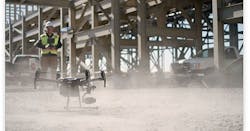SkyX Systems' UAVs chosen for long-range search missions in Canada
According to a recent announcement, 133 people have been rescued as a result of drone-operated missions worldwide from 2017 through the first half of 2018, showcasing the importance in deploying drone technology for search and rescue missions. However, quadcopter UAVs, the vehicle of choice for such missions, have multiple limitations, including endurance of the drone itself, the range at which it can operate without a controller, and the weather conditions they could operate in.
SkyX's system gets around those issues. SkyOne has been engineered with a range of at least 65 miles, endurance up to an hour and half, minimum speed of 40 mph and maximum speed of 75 mph, autonomous vertical takeoff and landing, and the ability to function effectively in a wide array of temperatures. The SkyX flight system can also be programmed and piloted remotely – suited for Beyond Visual Line of Sight (BVLOS) operations and negates the need for a pilot to be onsite to control the drone.
"Search and rescue missions are high-pressure, time-sensitive moments where every second counts in increasing the chances that we'll find individuals safe and unharmed," said William Bolton, Senior Trainer, Advanced Training in Search and Rescue, ATTSAR. "It's paramount that we use the latest technology to aid our efforts, which is why we've chosen to work with SkyX. The longer flight duration enables us to conduct missions in Southern Ontario over difficult terrain, along riverbeds, or long beachfronts. Additionally, SkyX BVLOS capabilities and ability to operate in various weather conditions – all of which set SkyX apart from other solutions – provides us comfort in knowing that we're partnering with best-in-class companies to maximize our chances of finding people quickly and safely."
Ready to make a purchase? Search the Intelligent Aerospace Buyer's Guide for companies, new products, press releases, and videos
